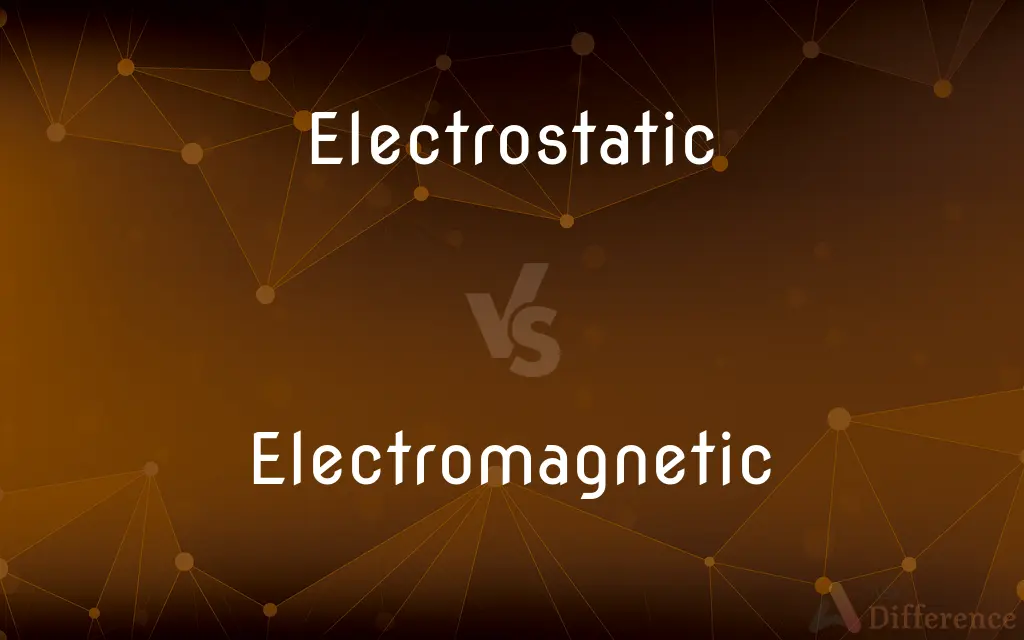Electrostatic vs. Electromagnetic — What's the Difference?
By Tayyaba Rehman & Urooj Arif — Updated on April 14, 2024
Electrostatics involves stationary electric charges and their fields, whereas electromagnetism includes moving charges and magnetic effects.

Difference Between Electrostatic and Electromagnetic
Table of Contents
ADVERTISEMENT
Key Differences
Electrostatics focuses on interactions between static (non-moving) electric charges. In contrast, electromagnetism deals with both electric and magnetic fields which are interrelated, especially when charges are in motion.
Electrostatic forces are the result of static charge interactions, typically described by Coulomb's law. Meanwhile, electromagnetic forces encompass a broader spectrum, including the Lorentz force, which affects moving charges in magnetic fields.
The field in electrostatics is purely electric and does not require the presence of magnets or moving charges. On the other hand, electromagnetic fields arise from both electric currents (moving charges) and magnetic materials.
Electrostatic phenomena, such as a balloon sticking to a wall after being rubbed, occur due to charge imbalances. Electromagnetic phenomena, such as the operation of electric motors or generators, involve the interaction of electric and magnetic fields.
In practical applications, electrostatic principles are key in areas like photocopiers and pollution control, where static charge plays a pivotal role. Electromagnetic principles, however, are fundamental to the functioning of most modern technology, including communications, power generation, and electronic devices.
ADVERTISEMENT
Comparison Chart
Definition
Study of stationary electric charges.
Study of electric and magnetic fields.
Forces Involved
Electrostatic force (Coulomb's law).
Electromagnetic force (including Lorentz force).
Field Dynamics
Static fields only.
Dynamic fields, affected by motion.
Typical Phenomena
Balloon sticking to a wall.
Operation of electric motors.
Key Applications
Photocopiers, static electricity.
Power generation, communications.
Compare with Definitions
Electrostatic
Concerned with the electric fields created by static charges.
The electrostatic field around a charged insulator does not change over time.
Electromagnetic
The branch of physics concerned with the forces that occur between electrically charged particles.
Electromagnetic theory explains both light and radio waves.
Electrostatic
Typically deals with phenomena where charges are accumulated on surfaces.
Electrostatic painting uses static charge to adhere paint to surfaces.
Electromagnetic
Fundamental to the operation of various devices, including transformers and inductors.
Electromagnetic induction is the principle behind the operation of transformers.
Electrostatic
The branch of physics that studies electric charges at rest.
Measuring the electrostatic force between two charged bodies.
Electromagnetic
Essential for the propagation of radio, microwaves, and light waves.
Cell phones communicate using electromagnetic waves.
Electrostatic
Involves the calculation and application of Coulomb's law.
Electrostatics is crucial in designing equipment that handles fine particulate matter.
Electromagnetic
Involves the interaction of electric currents and magnetic fields.
An electromagnetic field is generated around a wire carrying an electric current.
Electrostatic
Impacts everyday life through static cling and static shock.
Walking on a carpet can generate enough static electricity to produce a shock.
Electromagnetic
Interacts dynamically with charged particles and magnetic materials.
The electromagnetic force is responsible for the physical and chemical properties of atoms.
Electrostatic
Of or relating to electric charges at rest.
Electromagnetic
Of or exhibiting electromagnetism.
Electrostatic
Produced or caused by such charges.
Electromagnetic
Relating to electromagnetism
Electrostatic
Of or relating to electrostatics.
Electromagnetic
Pertaining to or exhibiting magnetism produced by electric charge in motion;
Electromagnetic energy
Electrostatic
(electricity) of, relating to, or produced by electrostatics or static electricity
Electrostatic
Pertaining to electrostatics.
Electrostatic
Concerned with or producing or caused by static electricity;
An electrostatic generator produces high-voltage static electricity
Common Curiosities
How do electrostatic charges accumulate?
Electrostatic charges accumulate through friction, contact, or induction between different materials.
What role do electromagnetic fields play in everyday technology?
Electromagnetic fields are crucial in powering and enabling functionality in devices like smartphones, radios, and MRI machines.
What is the key difference between electrostatic and electromagnetic forces?
Electrostatic forces arise from static charges, while electromagnetic forces involve moving charges and magnetic effects.
Are electromagnetic fields always associated with moving charges?
Yes, electromagnetic fields typically involve moving charges, such as those in an electric current.
What is an example of a purely electrostatic device?
A Van de Graaff generator is an example of a device that uses purely electrostatic principles to generate high voltages.
How do electromagnets differ from permanent magnets?
Electromagnets require an electric current to generate magnetic fields, whereas permanent magnets produce magnetic fields continuously without the need for electricity.
Is there a connection between electrostatics and weather phenomena?
Yes, electrostatic principles are involved in lightning and storm-related electrical phenomena.
Can electrostatic fields produce work?
Yes, electrostatic fields can produce work by moving charges over a distance, though the charges themselves are initially at rest.
How do electromagnetic waves propagate?
Electromagnetic waves propagate through space as oscillating electric and magnetic fields, moving perpendicular to each other.
What is Coulomb's Law?
Coulomb's Law quantifies the amount of force between two stationary, electrically charged particles.
Can electrostatic effects be shielded?
Yes, electrostatic effects can be shielded using materials that block or redistribute electric fields, such as conductive coatings.
How does electromagnetic induction work?
Electromagnetic induction occurs when a conductor moving through a magnetic field, or a changing magnetic field around a conductor, generates an electric current within the conductor.
What safety precautions are recommended for handling electromagnetic devices?
Safety precautions include avoiding direct contact with high-voltage components and using shielding to protect against electromagnetic radiation.
Why is electrostatic discharge a concern in electronics?
Electrostatic discharge can damage sensitive electronic components by suddenly releasing static electricity.
What are practical applications of electromagnetism in healthcare?
Electromagnetism is used in diagnostic tools like MRI machines and in treatments requiring precise doses of radiation.
Share Your Discovery

Previous Comparison
Distaff vs. Female
Next Comparison
Connoisseur vs. SpecialistAuthor Spotlight
Written by
Tayyaba RehmanTayyaba Rehman is a distinguished writer, currently serving as a primary contributor to askdifference.com. As a researcher in semantics and etymology, Tayyaba's passion for the complexity of languages and their distinctions has found a perfect home on the platform. Tayyaba delves into the intricacies of language, distinguishing between commonly confused words and phrases, thereby providing clarity for readers worldwide.
Co-written by
Urooj ArifUrooj is a skilled content writer at Ask Difference, known for her exceptional ability to simplify complex topics into engaging and informative content. With a passion for research and a flair for clear, concise writing, she consistently delivers articles that resonate with our diverse audience.















































